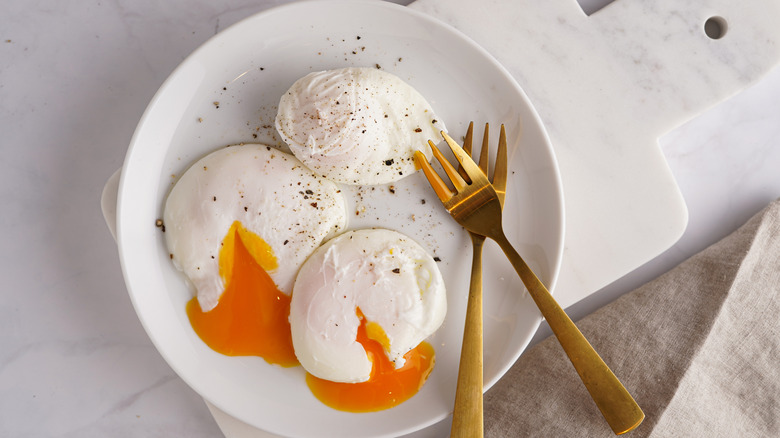For Easier 'Poached' Eggs, Try This Cooking Method Instead
Eggs Benedict, eggs Florentine, and salade Lyonnaise are just a few of the delicious recipes made with poached eggs. But for those of us yet to master the art of egg poaching, this can stand as a serious deterrent. One way around it is to poach eggs in the microwave, but eggs-pert Lisa Steele, host of the American Public Television and CreateTV series "Welcome to My Farm," suggests you could substitute in coddled eggs.
Before we get into the technique, we'll acknowledge some uncertainty surrounding the name. When Steele refers to coddled eggs, she's referring to eggs that are "baked in the oven in a water bath." It's not unusual to hear some people refer to coddled eggs as being prepared on the stove, instead referring to oven-baked eggs as shirred eggs. (Shirring is another way to prep eggs that no one ever talks about.) Compounding the confusion, there are those who use "coddled" to mean an extremely soft-boiled egg that's been cooked in its shell for just a minute or two. Steele isn't alone in her use of the term coddled instead of shirred, so we'll defer to her preference.
To coddle an egg, crack it into a greased ramekin then put it into a baking pan. Fill the pan halfway with water, then bake the egg for 15 minutes at 325 degrees Fahrenheit. "The texture is very similar to a poached egg," Steele told The Takeout. "And the method is much easier." While it's not necessary, seasonings can help. "You can add some cream, cheese, herbs, or spices to the eggs for variety and added flavor."
Poaching isn't as hard as you think
Even if coddled eggs are a good alternative to poached, Steele was confident anyone can learn the technique. "Poached eggs really isn't difficult at all once you master the technique," she said (though poaching perfection will require practice). Steele acknowledged that poaching can be scary for some, but reassured us, "With a few tips, achieving the perfect poach isn't hard."
For starters, Steele advises using the freshest egg possible and keeping it chilled, explaining that both freshness and cold will allow the egg white to better keep its shape. She also advocates straining it prior to poaching to remove any stray wisps of white. The egg should be cooked in four inches of simmering water to allow enough room so it won't touch the bottom. To make the poached egg more symmetrical, swirl a wooden spoon handle in the water to create a whirlpool. Slip the egg in, then swirl the water for a couple of seconds longer until the white starts to set. The egg should cook for two to three minutes (use a timer). It will be done when the white is entirely set and the yolk feels firm but still yields when poked lightly with a finger.
Once the egg is done, remove it from the water with a slotted spoon, then set it on a paper towel to drain. Congratulations, you've managed to poach an egg. Even if it doesn't look too pretty, it's a start — and remember, hollandaise sauce can cover a multitude of imperfections.

